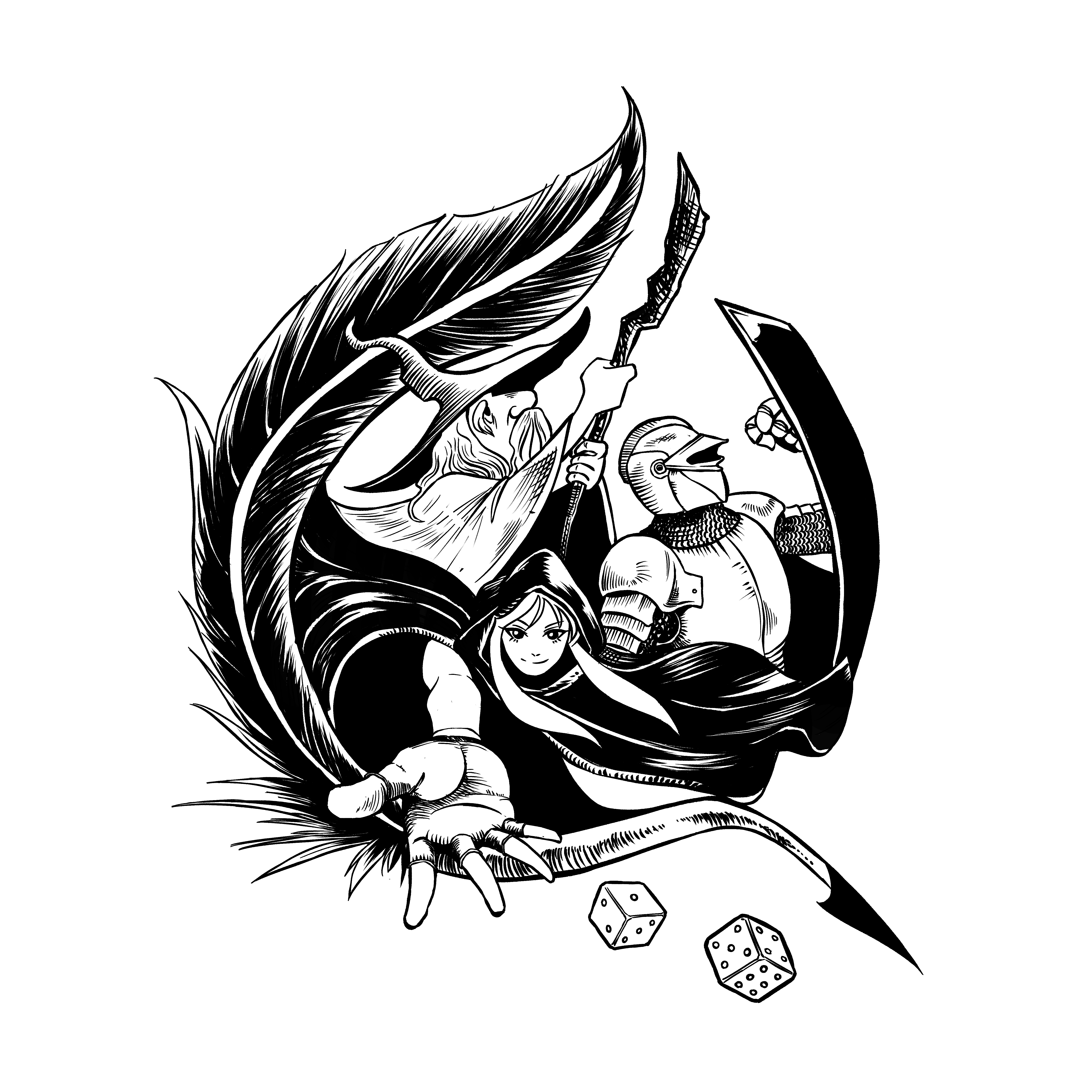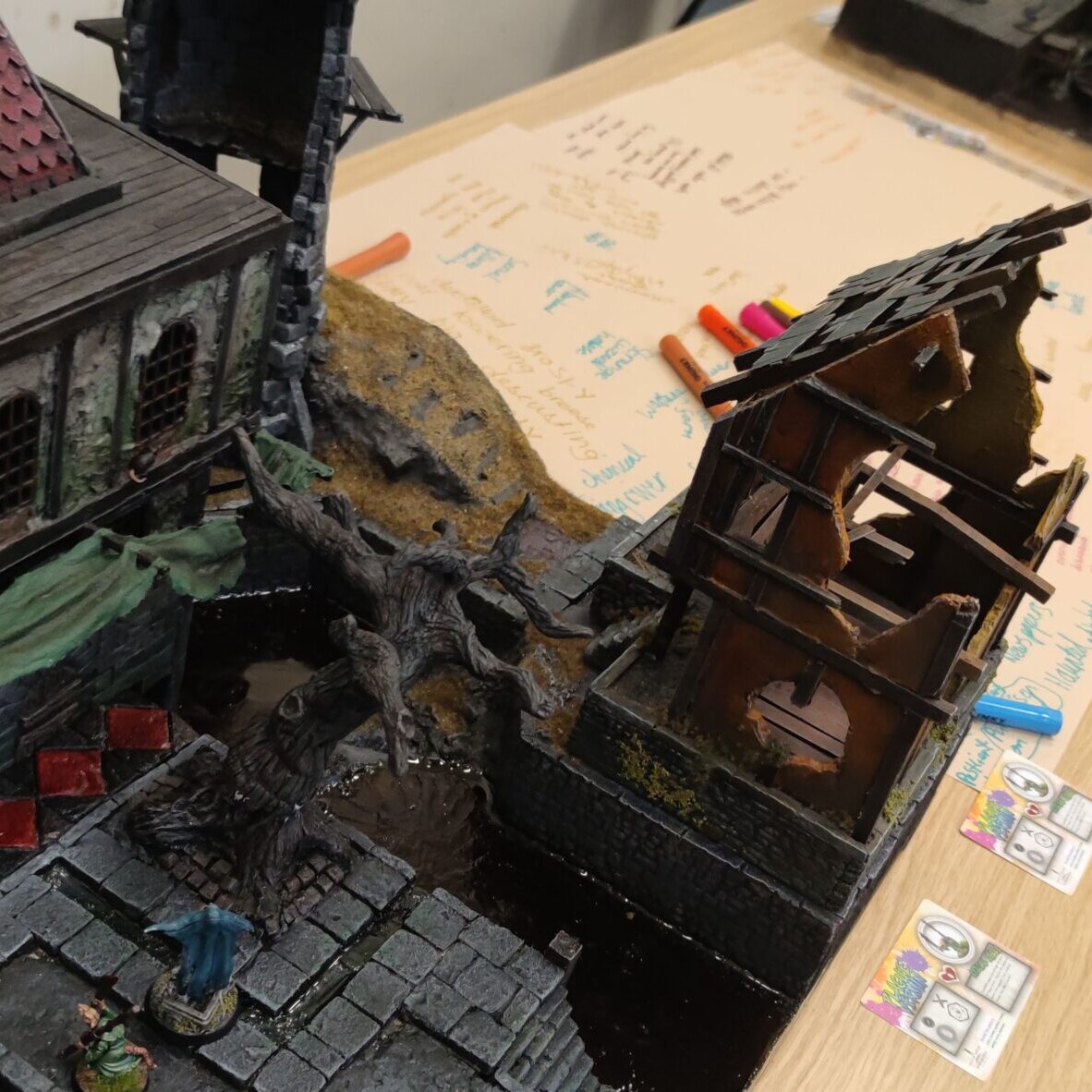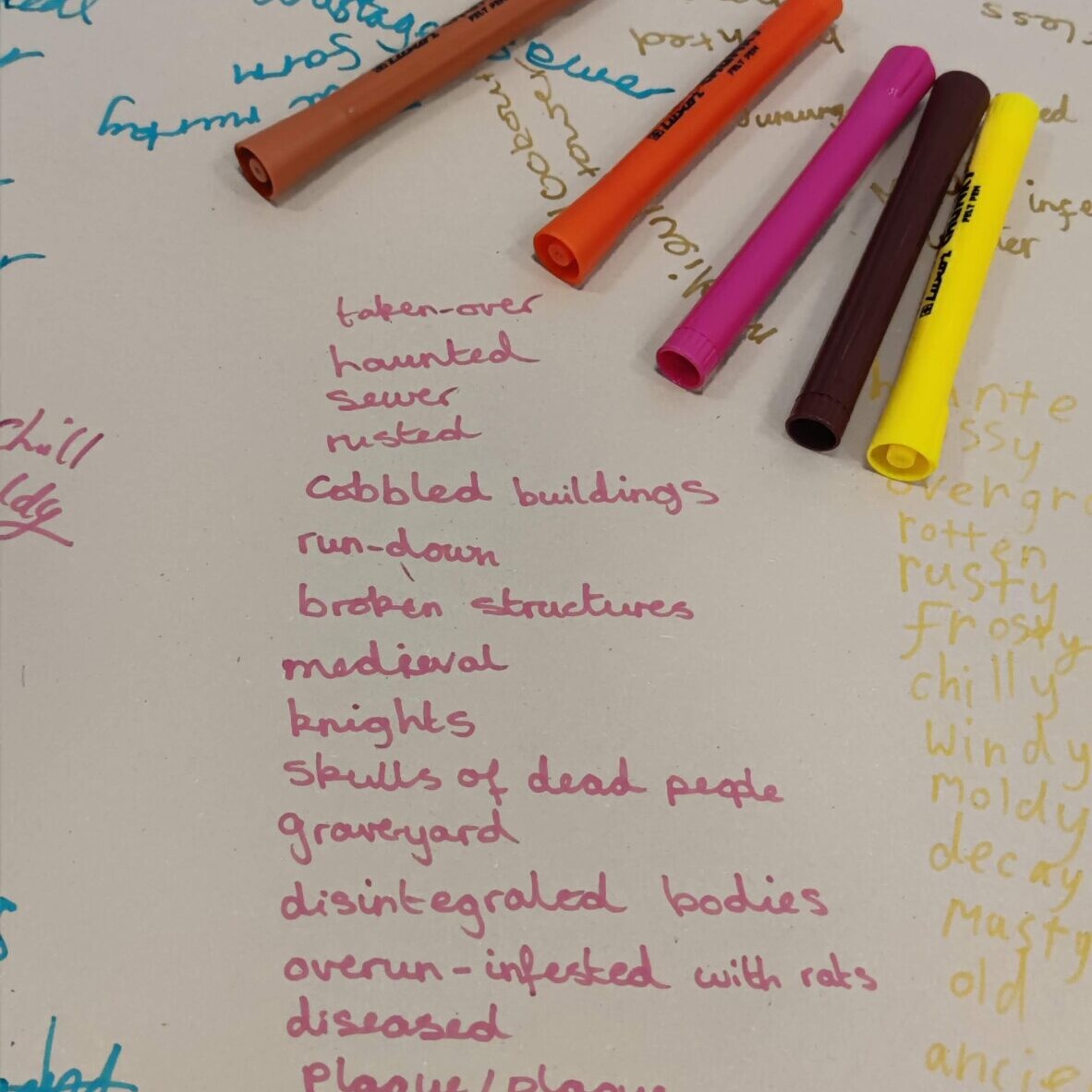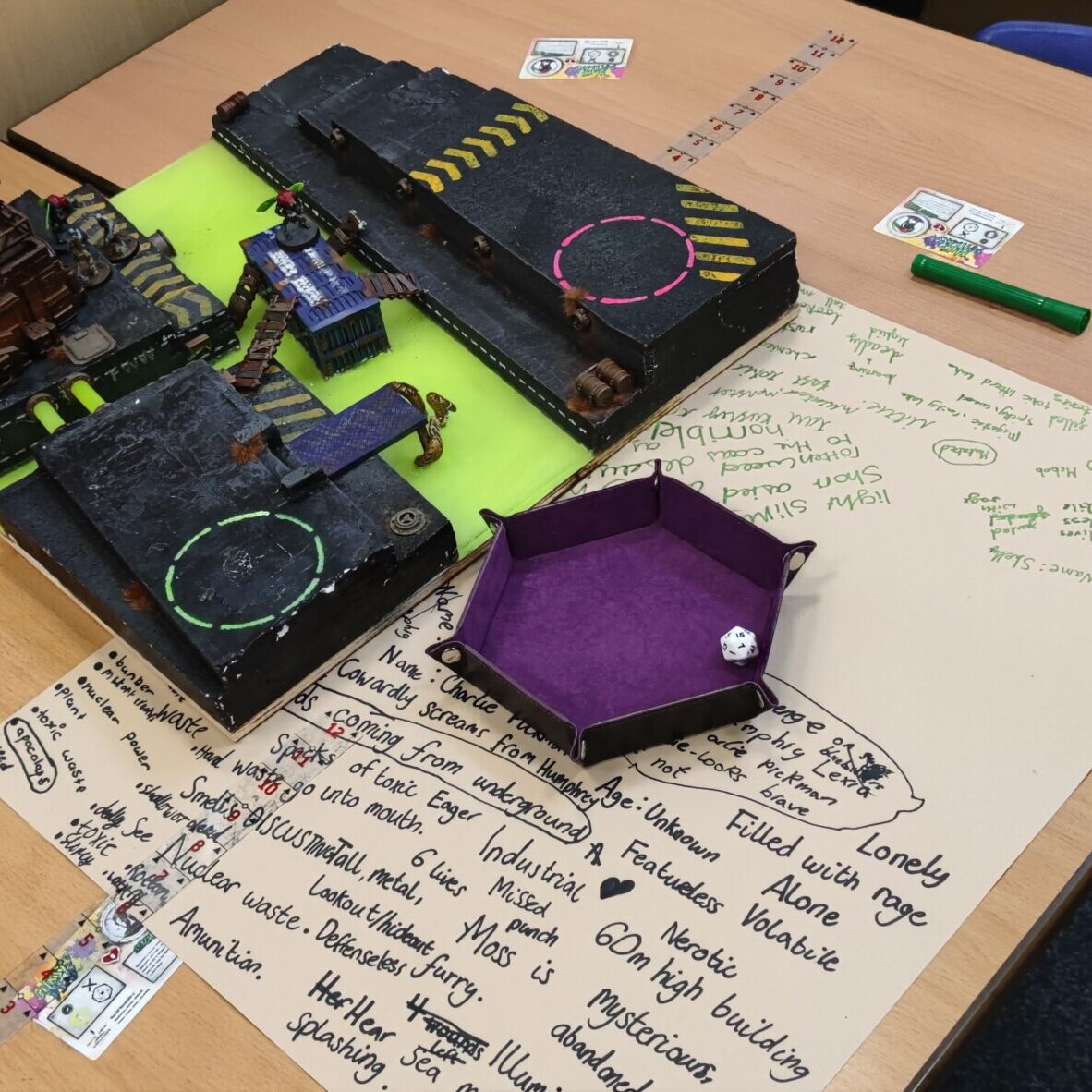Humans have been oral storytellers for millennia. We know that the first step towards writing great stories is telling them to each other. Quests & Quills is my popular role-play and talking-led writing workshop designed to engage every child in the narrative process. We use a variety of props and gameplay to help guide your children's stories, but the creative spark and imagination are entirely their own.
When I left teaching in 2019, I wanted to create a workshop that would combine my love of tabletop role-play games (such as Dungeons & Dragons) with my passion for inspiring writing. Quests & Quills breaks down many barriers children face when writing a narrative, allowing them to concentrate on simply telling the story. When they don’t need to conjure up a whole world, fabricate the description of a character or even construct a plot, they are free to think about how they can describe everything that is happening in front of them.

- Every child is given a physical model to represent their character. There is no need to conjure up a physical description; instead, they are free to think more deeply about the character's motivation or emotions as the story progresses.
- The world is there on the tables in front of them. Every aspect is painstakingly created by myself to enhance the story-telling potential. Instead of thinking about what the world might look like, children are free to focus on how their character interacts with it.
- Quests & Quills is a turn-based workshop that uses simple rules to dictate the play. The narrative unfolds in front of their eyes as the game takes place; all the children have to do is think about how they can tell that story in a way that captivates their audience.
- By taking turns, children are encouraged to work collaboratively and engage with groups they might otherwise avoid. The story progresses naturally, with each child adding their own voice to the narrative.
The workshop begins with the children being introduced to the boards and their characters. These will be the tools they use to play the games throughout the workshop.
Groups of 4 or 6 are best, so the children are divided into small groups. They will work in two teams of 2 or 3 to play against each other. Their characters form a “clan” that has ventured into their world and discovered the other “clan”.
The children are given time to think about the backstory of their character. I talk them through creating characters as an author, and we look at why their character might be there and what their aims and motivations are. Are they there to seek treasure and glory or for revenge? Are they there against their will, desperately seeking their own freedom? All of these decisions will help to guide their narrative later.
The rules of the game are deliberately light. After a quick introduction, the children are given time to familiarise themselves with the process. This doesn’t take long, and they are encouraged to work as a team to add other rules that will improve their narrative. These might include rules for leaping from one building to another or traversing across rivers.
Once the children are familiar with how to play, we begin to explore the narrative. The game is turn-based, which means that each child takes their turn and then waits for everybody else to make theirs. During this waiting time, they narrate what has just happened to their character. This can be written down, told orally or recorded in various other ways, depending on your preference.
As each of the other players takes their turn, the other children will continue to tell their story as they react. Perhaps one of their allies gets into trouble, or their own character might be attacked. Breaking the story down into small sections encourages them to build tension and guide the reader towards a satisfactory conclusion rather than jumping ahead and ending the story quickly.
As the workshop draws to a close, we gather together and tell parts of our narrative to the class. We explore how two characters in the same game might have very different narratives because of the characters’ points of view. One character might be mocking their enemy for running away scared, whereas that character might tell a story of how they bravely hid in the shadows and struck unexpectedly. We link this back to stories that they might know and how different they would be if told from another perspective.
For a brief visual introduction, I recommend watching the video below.
Narrative
Structure
A story should take the reader on a journey. Quests & Quills workshops scaffold a strong narrative structure by guiding the children through the process. They can’t rush to the end or skip the build-up because the story unfolds in front of them as they play the game. Each step of the adventure is chronicled, demonstrating how a structured narrative works.
Accessible
To All
Quests & Quills workshops are designed to include everybody in the group. Whether that’s a small group with additional needs or a whole class, I aim to get everybody involved in the process. That’s one of the reasons why the outcomes are so flexible – each child can achieve no matter their ability or engagement with writing.
Collaborative
Writing
No story is written alone. Sharing ideas and listening to other people is a critical writing skill. Quests & Quills workshops aren’t quiet—children naturally engage in story-telling as their characters battle in the worlds I have created. As they listen to each other, they take on board new ideas, which inevitably end up in their own narrative.
Unlocking
Ideas
I firmly believe that all children are able to tell stories. Removing some of the barriers, such as having to create characters, worlds, and plots from scratch, helps unlock that potential. Those children who flourish when using their imagination still have a broad scope to add their own flair to the narratives, while those who struggle have the scaffolding needed to guide them.
Author-Led
Sessions
As an author, I fill each session with advice and guidance on how to use skills that I use every day to make their narratives better. We discuss how to build believable and relatable characters, how to write engaging action and how to describe worlds that readers want to visit. All of this is scaffolded by the tools provided.
Flexible
Outcomes
How the narratives are recorded in a Quests & Quills workshop is down to you and your setting. With smaller groups or shorter sessions, some teachers prefer to assign a scribe to record each group’s narrative. Some prefer to keep the workshops verbal or have the children take quick notes and write the narrative afterwards. Others use digital devices to record videos, audio, or even stop-motion animation! Some of this will depend on the session length, but I will discuss the options in our pre-workshop chat.
A Quests & Quills workshop ties in with many curriculum objects across Key Stages 2 and 3. Many of these are covered naturally as part of the workshop (highlighted in blue), whilst the others can easily be targetted if they are a priority for you. As always, I'm happy to discuss any outcomes that you have in mind.
- Composing and rehearsing sentences orally (including dialogue), progressively building a varied and rich vocabulary and an increasing range of sentence structures
- Organising paragraphs around a theme
- In narratives, creating settings, characters and plot
- Assessing the effectiveness of their own and others’ writing and suggesting improvements
- Read their own writing aloud to a group or the whole class, using appropriate intonation and controlling the tone and volume so that the meaning is clear
- Using the present perfect form of verbs in contrast to the past tense
- Using conjunctions, adverbs and prepositions to express time and cause
- Using fronted adverbials
- Identifying the audience for and purpose of the writing, selecting the appropriate form and using other similar writing as models for their own
- Selecting appropriate grammar and vocabulary, understanding how such choices can change and enhance meaning
- In narratives, describing settings, characters and atmosphere and integrating dialogue to convey character and advance the action
- Using a wide range of devices to build cohesion within and across paragraphs
- Assessing the effectiveness of their own and others’ writing
- Ensuring the consistent and correct use of tense throughout a piece of writing
- Perform their own compositions, using appropriate intonation, volume, and movement so that meaning is clear
- Using passive verbs to affect the presentation of information in a sentence
- Using expanded noun phrases to convey complicated information concisely
- Using modal verbs or adverbs to indicate degrees of possibility
- Using relative clauses beginning with who, which, where, when, whose, that or with an implied (ie omitted) relative pronoun
- Write effectively for a range of purposes and audiences, selecting language that shows good awareness of the reader
- In narratives, describe settings, characters and atmosphere
- Integrate dialogue in narratives to convey character and advance the action
- Select vocabulary and grammatical structures that reflect what the writing requires, doing this mostly appropriately
- Use a range of devices to build cohesion
- Use verb tenses consistently and correctly throughout their writing
- Distinguish between the language of speech and writing and choose the appropriate register
- Exercise an assured and conscious control over levels of formality, particularly through manipulating grammar and vocabulary to achieve this
- Writing for a wide range of purposes and audiences, including: Stories, scripts, poetry and other imaginative writing
- Applying their growing knowledge of vocabulary, grammar and text structure to their writing and selecting the appropriate form
- Drawing on knowledge of literary and rhetorical devices from their reading and listening to enhance the impact of their writing
- Considering how their writing reflects the audiences and purposes for which it was intended
- Amending the vocabulary, grammar and structure of their writing to improve its coherence and overall effectiveness
- Drawing on new vocabulary and grammatical constructions from their reading and listening, and using these consciously in their writing and speech to achieve particular effects
- Using Standard English confidently in a range of formal and informal contexts, including classroom discussion
I provide everything so you can sit back and join in with the process. Before I arrive, there are some things that you might want to discuss with the group.
- Discuss the outcomes. Explain whether they will be expected to write their narrative or take notes; will they need resources such as iPads or cameras (these are the only things you will need to provide), and are they fully charged?
- Explain expectations around the equipment. The battle boards and characters that we will use have been painstakingly built by myself, and they take time. Accidents happen, and things get broken, but these can be reduced with a few simple rules.
- Don’t bash the miniatures together; it isn’t needed for the story, and it will break them!
- Tie hair back where possible – you’d be surprised how many miniatures or bits of terrain get caught in dangling hair when a child leans over the board!
- The same goes for loose cardigans, sleeves or lanyards.
- Any fighting is fought on the battle boards. Arguing, cheating or taking other people’s turns only ruins the experience for the group. Working as a team will result in a better narrative and a lot more fun for everyone.
- This isn’t a quiet workshop! There will be cheering, talking and disappointed groans when things don’t go your way. Use those emotions in your narrative. If you are happy, so is your character. If you are despondent, think about how your body is responding and add that to your character’s reaction.
- Read through the sample clan descriptions. I can’t guarantee that everybody will be able to have the characters that they want, but this will give them an idea of what to expect.
- You might want to look at examples of fantasy settings and discuss language that could be used to describe them. We will focus on the senses, particularly those other than sight, and how they can help to build a richer world for the reader.
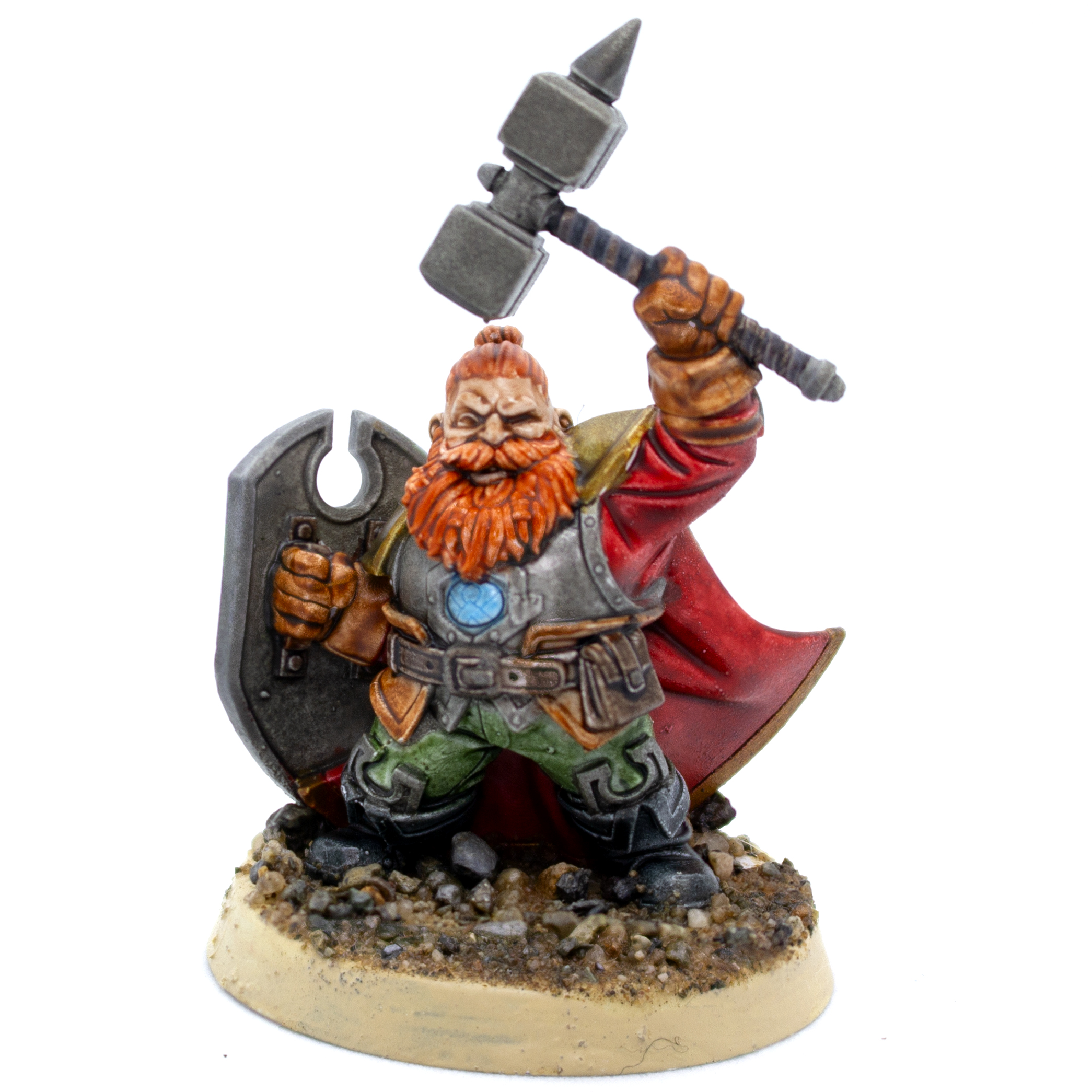
I've tried to answer the most common questions here, but if there's anything else you'd like to know, drop me an email through the contact form below.
Each “game” works best with groups of four or six. I bring enough equipment to work with a group of up to 36 children, but it is also dependent on your space. Each group would need a standard school table to work at, so you would need enough space to accommodate that. I haven’t had any issues with a standard class size before.
For longer, more focussed sessions, I can also run it with a focussed group of up to 8 children. For example, this could be a greater depth group where we focus more on adding detail and innovation to their writing or an SEN group with a greater focus on interpersonal skills and oral storytelling.
Absolutely. There may be additional travel costs outside of mainland England, but I am always happy to travel.
Not at all. The premise of the game is rooted in traditional role-playing games such as Dungeons & Dragons and tabletop games such as Warhammer. There is always a strong focus on playing fairly and working as a team, which is carried through every workshop.
Believe it or not, I’ve been asked this a few times. Yes, Quests & Quills is entirely suitable for girls. They get just as much out of battling with each other as anybody! There is a wide range of characters of all genders and fantasy races. I have several characters in wheelchairs and am always looking for more representation where I can find it.
There are two things that I would recommend if you’ve enjoyed a Quests & Quills workshop.
Firstly, check out my YouTube channel at https://youtube.com/@questsquills. There, I go through the process of making all of the terrain and painting the figures. All of my videos are designed with beginners in mind, so they are perfect for starting your own hobby club at school and learning the basics.
Second, definitely check out Warhammer Alliance from Games Workshop at https://warhammer-alliance.com/uk/. This is a fantastic free resource from Games Workshop, designed with schools in mind. They will send you everything you need to get started with a hobby club, from miniatures and paints to rulers, dice and rules. It’s a great way to carry on the engagement. All I ask is that you let them know that I sent you if you sign up!
Interested in what you've seen? Get in touch using the form below.
